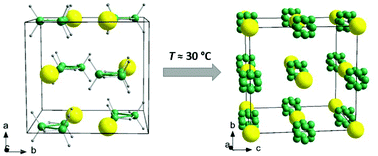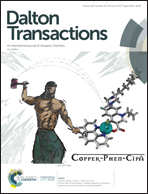Potassium octahydridotriborate: diverse polymorphism in a potential hydrogen storage material and potassium ion conductor†
Abstract
Octahydridoborate, i.e. [B3H8]− containing compounds, have recently attracted interest for hydrogen storage. In the present study, the structural, hydrogen storage, and ion conductivity properties of KB3H8 have been systematically investigated. Two distinct polymorphic transitions are identified for KB3H8 from a monoclinic (α) to an orthorhombic (α′) structure at 15 °C via a second-order transition and eventually to a cubic (β) structure at 30 °C by a first-order transition. The β-polymorph of KB3H8 displays a high degree of disorder of the [B3H8]− anion, which facilitates increased cation mobility, reaching a K+ conductivity of ∼10−7 S cm−1 above 100 °C. β-KB3H8 starts to release hydrogen at ∼160 °C, simultaneously with the release of B5H9 and trace amounts of B2H6. KBH4 and K3(BH4)(B12H12) are identified as crystalline decomposition products above 200 °C, and the formation of a KBH4 deficient structure of K3−x(BH4)1−x(B12H12) is observed at elevated temperature. The hydrogen-uptake properties of a KB3H8–2KH composite have been examined under 380 bar H2, resulting in the formation of KBH4 at T ≥ 150 °C along with higher metal hydridoborates, i.e. K2B9H9, K2B10H10, and K2B12H12.



 Please wait while we load your content...
Please wait while we load your content...